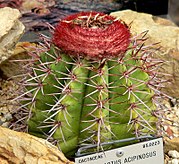
The flag of the British Overseas Territory of Bermuda as a red ensign was first adopted on 4 October 1910. It is a British Red Ensign with the Union Flag in the upper left corner, and the coat of arms of Bermuda in the lower right. Prior to this like most of the British colonies at the time it adopted a blue ensign with a seal that depicted a dry dock with three sailing ships. In 1999, the flag was changed to its current form, with an enlarged coat of arms.

The current flag of the Falkland Islands was adopted on 25 January 1999 and consists of a defaced Blue Ensign, with the Union Flag in the canton and the Falkland Islands coat-of-arms in the fly.

The flag of Montserrat consists of a Blue Ensign defaced with the British overseas territory's coat of arms. Adopted in 1960 to supplement the Union Jack after the dissolution of the British Leeward Islands the year before, it has been the flag of Montserrat since the territory was granted self-government that year. The design of the present flag entailed enlarging the coat of arms and outlining it with a white trim. Montserrat's flag is similar to the flags of eight other British Overseas Territories, which are also Blue Ensigns with their respective coats of arms.

The flag of Saint Helena consists of a Blue Ensign defaced with the shield from the British overseas territory's coat of arms. Adopted in 1984 shortly after the island was granted a new coat of arms, it has been the flag since. Saint Helena's flag is similar to the flags of eight other British Overseas Territories, which are also Blue Ensigns with their respective coats of arms.

The flag of the British Virgin Islands was adopted by Royal Warrant on 15 November 1960 after the islands were made into a separate British colony. Previously, the territory was administered as part of the British Leeward Islands.
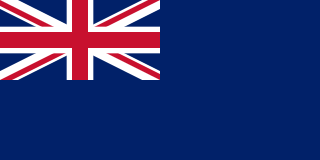
The Blue Ensign is a flag, one of several British ensigns, used by certain organisations or territories associated or formerly associated with the United Kingdom. It is used either plain or defaced with a badge or other emblem.

The flag of the Cayman Islands consists of a Blue Ensign defaced with the British overseas territory's coat of arms. Adopted in 1959 to supplement the Union Jack and to replace the flag of the Colony of Jamaica, it has been the flag of the Cayman Islands since the territory was granted self-government that year. The design of the present flag entailed removing the white disc and outlining the coat of arms with a white trim, although the previous version is often used in an official capacity. The Cayman Islands' flag is similar to the flags of eight other British Overseas Territories, which are also Blue Ensigns with their respective coats of arms.

Before European colonization, the Turks and Caicos Islands were inhabited by Taíno and Lucayan peoples. The first recorded European sighting of the islands now known as the Turks and Caicos occurred in 1512. In the subsequent centuries, the islands were claimed by several European powers with the British Empire eventually gaining control. For many years the islands were governed indirectly through Bermuda, the Bahamas, and Jamaica. When the Bahamas gained independence in 1973, the islands received their own governor, and have remained a separate autonomous British Overseas Territory since. In August 2009, the United Kingdom suspended the Turks and Caicos Islands' self-government following allegations of ministerial corruption. Home rule was restored in the islands after the November 2012 elections.

The flag of the governor general of Canada is a flag used as a symbol to mark the presence of the governor general of Canada. Such a flag has been used by governors general since just after Canadian Confederation and the design has altered over decades. The current flag was adopted in 1981.

The flag of the British Antarctic Territory was granted on 21 April 1998. It features the coat of arms granted on 1 August 1963, a year after the British Antarctic Territory, a British Overseas Territory, was created. Previously, the Territory was a part of the Falkland Islands Dependencies and used the same flag. On 30 May 1969, a blue ensign with the British Antarctic Territory coat of arms in the fly was introduced as a government ensign.
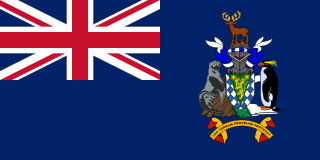
The flag of South Georgia and the South Sandwich Islands was granted on 3 October 1985, when the Territory was created. Previously the Territory was a part of the former Falkland Islands Dependencies and used the same flag as the Falklands Islands.
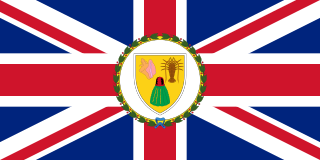
The governor of the Turks and Caicos Islands is the representative of the British monarch in the United Kingdom's British Overseas Territory of Turks and Caicos Islands. The Governor is appointed by the monarch on the advice of the British government. The role of the governor is to act as the vice-regal representative of the head of state, His Majesty King Charles III. The Governor appoints the Premier and 5 members of the House of Assembly. The official residence of the governor is the Government House of Turks and Caicos Islands, located in Waterloo on the island of Grand Turk.

The coat of arms of Tristan da Cunha was granted on 20 October 2002.
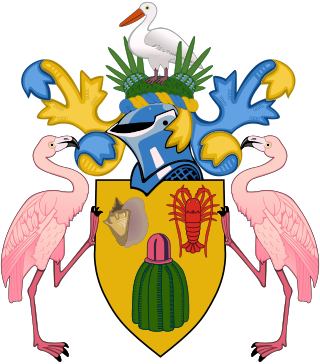
The coat of arms of the Turks and Caicos Islands consists of a gold-coloured escutcheon (shield) charged with a conch shell, lobster and a cactus, supported by two flamingos, and topped with a pelican in the crest. Adopted three years after the islands became a Crown colony, it has been the coat of arms of the Turks and Caicos Islands since 1965. The escutcheon is featured on the flag of the territory. The previous badge featured two mounds of salt in front of a ship, with doors added to the mounds after they were reportedly mistaken for igloos.
A civil ensign is an ensign used by civilian vessels to denote their nationality. It can be the same or different from the state ensign and the naval ensign. It is also known as the merchant ensign or merchant flag. Some countries have special civil ensigns for yachts, and even for specific yacht clubs, known as yacht ensigns.

The flag of Ascension Island, part of the British overseas territory of Saint Helena, Ascension and Tristan da Cunha, was adopted on 11 May 2013. The flag is a blue ensign design, defaced with the coat of arms of Ascension Island.
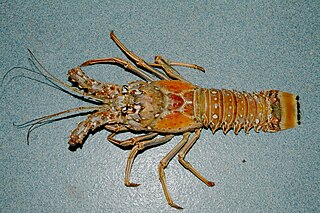
Panulirus argus, the Caribbean spiny lobster, is a species of spiny lobster that lives on reefs and in mangrove swamps in the western Atlantic Ocean.

Since unification in 1910, South Africa has used a range of national symbols to identify the country: coats of arms, official seals, flags, national anthems, and floral, bird, animal, and other emblems.
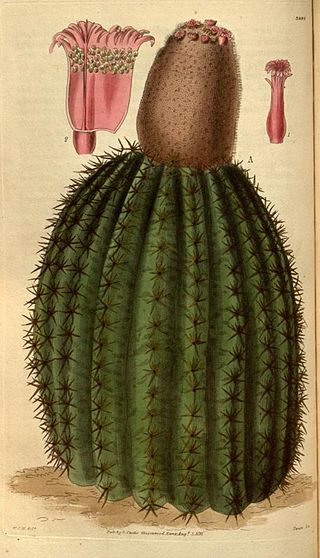
Melocactus intortus, also known as the Turk's cap cactus, is a species of cactus endemic to the Caribbean.
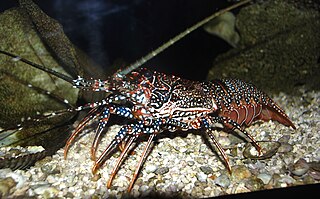
Panulirus guttatus, the spotted spiny lobster or Guinea chick lobster, is a species of spiny lobster that lives on shallow rocky reefs in the tropical West Atlantic and Caribbean Sea.



